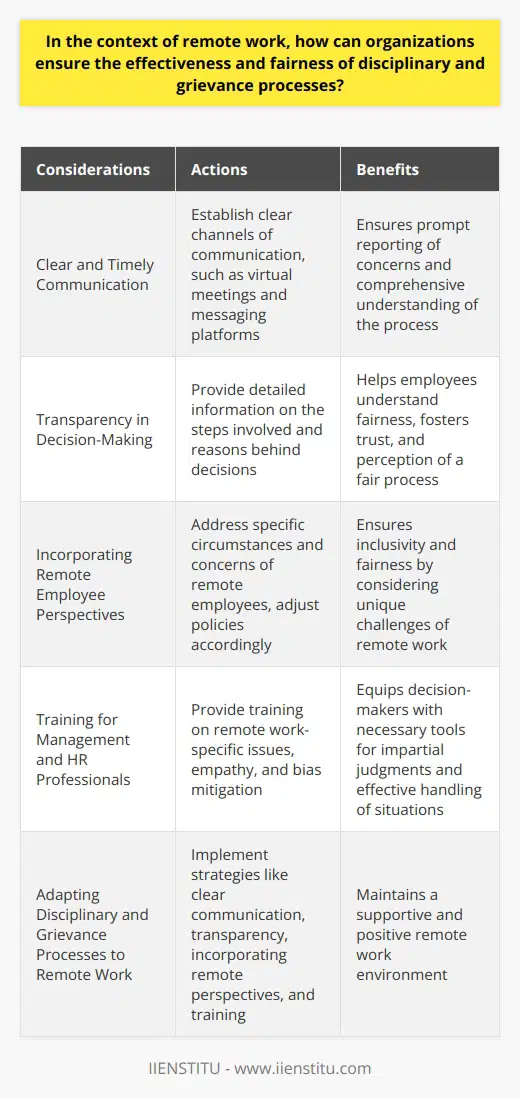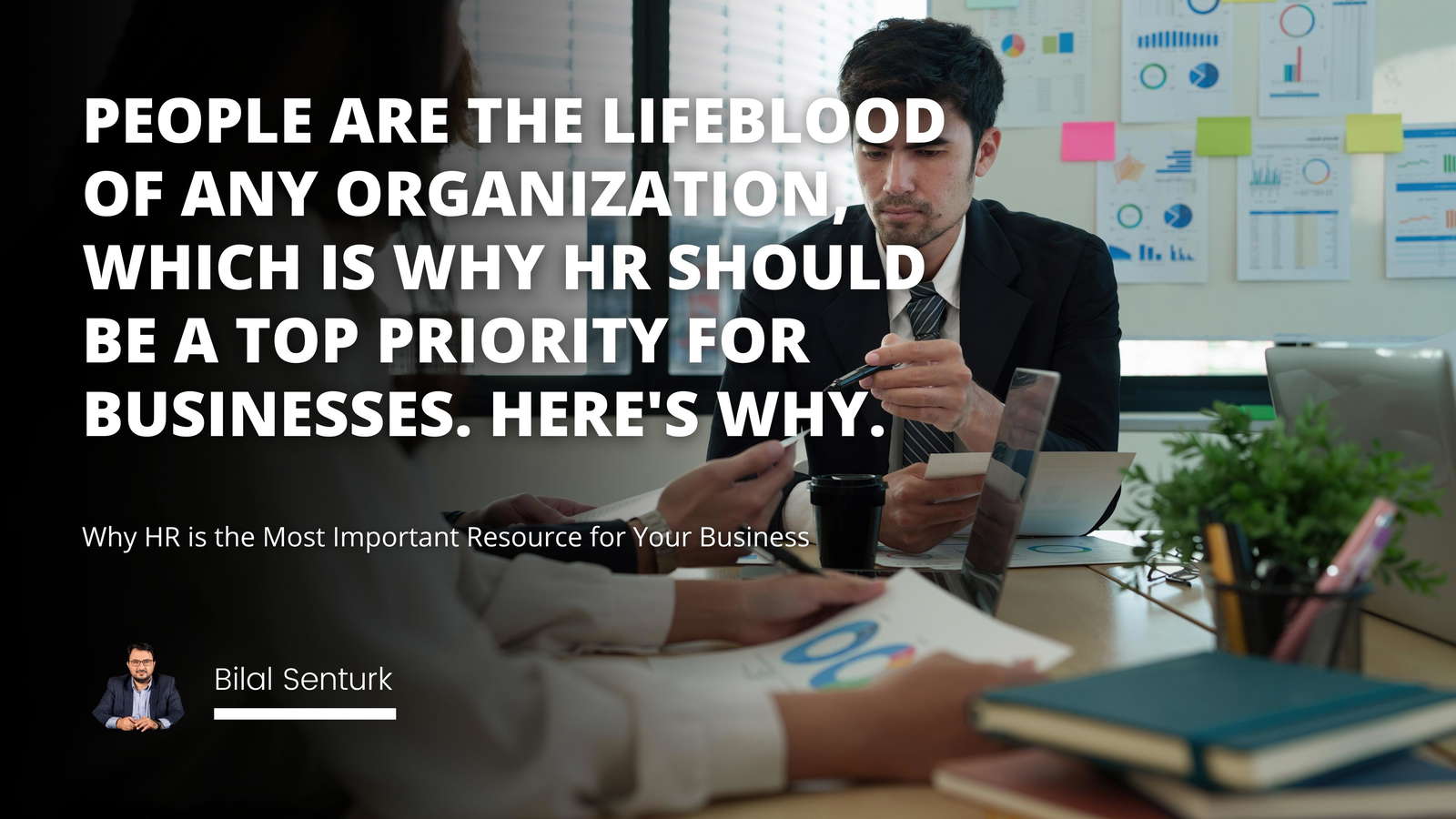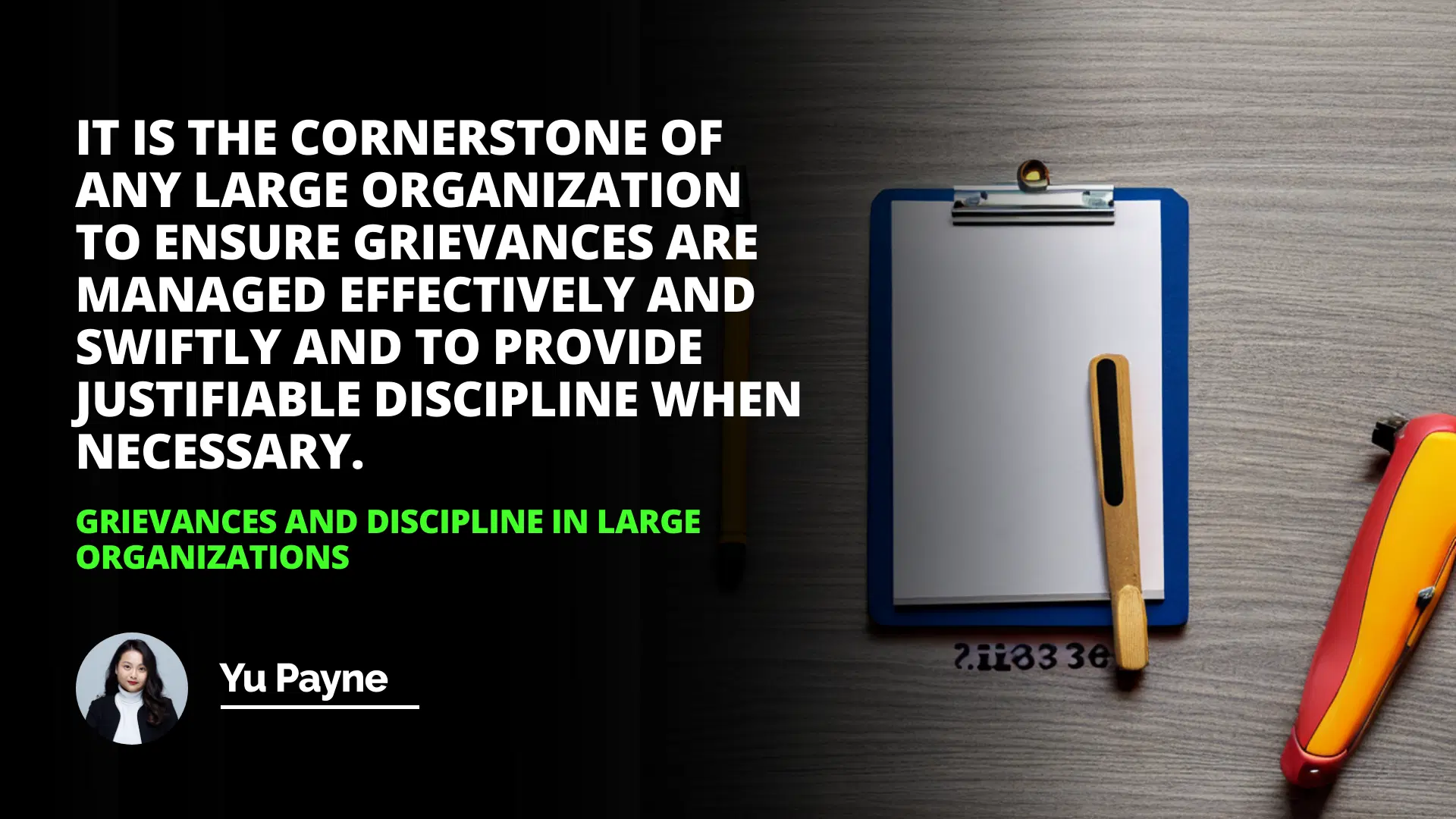
When I first joined a large organization straight out of college, I was brimming with enthusiasm and ready to make my mark. But it didn't take long for me to realize that the corporate world is a complex web of relationships, expectations, and procedures. One area that particularly stood out to me was how grievances and discipline were handled. Understanding these concepts wasn't just about knowing the rules— it was about appreciating the delicate balance of maintaining a positive work environment while ensuring productivity and fairness.
Understanding Grievances and Discipline in Large Organizations
Reasons for Grievances and Discipline
Grievance and Discipline Procedures
Navigating the Maze: Grievances and Discipline in Large Organizations
In any sizable company, you're likely to encounter a vast diversity of people, each with their own backgrounds, perspectives, and working styles. Grievances and discipline become the tools by which organizations manage conflicts and uphold standards. But what exactly do these terms mean in practice?
What is a Grievance?
A grievance is essentially a formal complaint raised by an employee towards an employer. This could be due to a myriad of reasons, such as unfair treatment, unsafe working conditions, disagreements with company policies, or conflicts with colleagues. I remember a colleague, let's call him John, who felt his workload was significantly heavier than others in his team. He believed this was impacting his work-life balance and causing undue stress. John decided to raise a grievance, seeking a fairer distribution of tasks.
Workplace Harassment: Effects, Legal Issues and Prevention Strategies
Human Resources: From Reactive to Proactive in the Workplace
Human Resources Job Description: Your Comprehensive Guide to HR Roles
Grievances are crucial because they give employees a voice. They provide a structured way for concerns to be heard and addressed. Without this outlet, frustrations can fester, leading to decreased morale and productivity.
Understanding Discipline
On the flip side, discipline in an organization refers to the actions taken by management to correct undesirable behavior or performance issues. This isn't about wielding authority unjustly but about ensuring that everyone adheres to agreed-upon standards and policies. I once witnessed a situation where an employee was consistently late, impacting team meetings and project timelines. After informal discussions didn’t yield a change, the management had to initiate formal disciplinary action.
Discipline ensures that there's fairness and consistency in how rules are enforced. It helps maintain a level playing field, so everyone knows what's expected of them and the consequences of not meeting those expectations.
Delving Deeper: Reasons Behind Grievances and Discipline
Understanding the root causes of grievances and the need for discipline can help organizations address underlying issues before they escalate.
It is the cornerstone of any large organization to ensure grievances are managed effectively and swiftly and to provide justifiable discipline when necessary.

Common Reasons for Grievances
Poor Communication: Misunderstandings often arise when there's a lack of clear communication. This can lead to confusion about job roles, expectations, or company policies.
Workload Imbalance: Feeling overburdened or perceiving that others aren't pulling their weight can cause resentment.
Lack of Recognition: Everyone likes to feel appreciated. When hard work isn't acknowledged, it can lead to dissatisfaction.
Bullying and Harassment: Unfortunately, negative behaviors like bullying or harassment can occur, necessitating immediate attention.
Unsafe Working Conditions: Employees have the right to a safe work environment. Any hazards or risks can be grounds for a grievance.
I recall attending a seminar where a speaker highlighted that 70% of workplace grievances stem from interpersonal conflicts rather than actual job duties. This underscores the importance of fostering positive relationships within teams.
Reasons for Disciplinary Actions
Violation of Company Policies: This could range from breaches of confidentiality to not adhering to dress codes.
Poor Performance: Consistently failing to meet performance standards or deadlines.
Attendance Issues: Regular lateness or unexplained absences.
Insubordination: Refusal to follow legitimate instructions from supervisors.
Misconduct: This includes behaviors like theft, fraud, or any actions that could harm the company's reputation.
Implementing discipline isn't about punishment; it's about guiding employees back onto the right path.
Grievance and Discipline Procedures: The Roadmap to Resolution
Having clear procedures in place is essential. It ensures that both grievances and disciplinary actions are handled fairly, consistently, and legally.
Grievance Procedures
1- Informal Discussion: Often, issues can be resolved through a simple conversation. Employees are encouraged to speak directly with their immediate supervisor.
2- Formal Written Complaint: If the issue isn’t resolved informally, the employee submits a formal grievance in writing.
3- Investigation: The organization investigates the complaint, which may involve interviews and reviewing relevant documents.
4- Meeting: A meeting is scheduled between the employee and management to discuss the grievance.
5- Decision: After considering all the information, management provides a decision.
6- Appeal Process: If unsatisfied, the employee can appeal the decision, leading to a review by a higher authority within the organization.
Discipline Procedures
1- Verbal Warning: The first step is usually an informal discussion to highlight the issue.
2- Written Warning: If the behavior persists, a formal written warning is issued.
3- Final Written Warning: Continued non-compliance leads to a final warning, emphasizing the seriousness of the matter.
4- Suspension: Temporary removal from the workplace might be necessary in some cases.
5- Termination: As a last resort, the employee may be dismissed from the organization.
These steps ensure that employees are given ample opportunity to correct their behavior and that any actions taken are justified.
Personal Reflections: Lessons Learned
During my tenure, I've seen firsthand how effectively managed grievance and discipline processes can lead to positive outcomes. For instance, in a previous role, a teammate, Sarah, felt she was being overlooked for promotions despite her hard work. Instead of bottling up her frustrations, she utilized the grievance procedure. Through the process, it became evident that there was a communication gap regarding performance expectations. The outcome? Sarah received additional support, and within months, she was promoted. This not only boosted her morale but also set an example for others about the power of open communication.
On the other hand, I've also observed situations where the lack of clear disciplinary procedures led to inconsistencies. In one department, employees were uncertain about the consequences of repeated lateness because management didn't enforce the rules consistently. This led to confusion and a drop in team morale. It was a classic case of how ambiguity can undermine authority and trust within a team.
The Human Element: Building a Positive Workplace Culture
At the heart of grievances and discipline is the goal of fostering a healthy work environment. It's not just about rules and procedures but about people.
Tips for Employees
Communicate Openly: If something's bothering you, don't be afraid to speak up. Often, issues can be resolved before they escalate.
Understand Policies: Familiarize yourself with the company's grievance and discipline procedures. Knowledge is power.
Stay Professional: Even when emotions run high, maintaining professionalism can lead to better outcomes.
Tips for Management
Listen Actively: When employees raise concerns, give them your full attention. Sometimes, all it takes is feeling heard.
Be Consistent: Apply policies uniformly to build trust within your team.
Provide Support: Offer resources like counseling or training to help employees improve.
By taking these steps, organizations can optimize their internal processes, much like businesses aim to optimize supply chain management process tips to enhance efficiency and reduce costs.
The Bigger Picture: Why It All Matters
Grievances and discipline are more than just HR procedures—they're vital components of organizational health. Properly managed, they can lead to:
Increased Employee Satisfaction: When issues are addressed promptly, employees feel valued.
Enhanced Productivity: A harmonious work environment boosts morale and efficiency.
Reduced Legal Risks: Clear procedures protect the organization from potential litigation.
Better Reputation: Companies known for fair treatment attract top talent.
In the words of renowned management theorist Peter Drucker, "Management is doing things right; leadership is doing the right things." Addressing grievances and discipline effectively is about doing the right things for your people and your organization.
Conclusion: Charting the Path Forward
Reflecting on my journey, I realize that understanding and engaging with grievance and discipline procedures isn't just for managers or HR professionals. It's for everyone. By actively participating in these processes, we contribute to a culture of transparency, fairness, and mutual respect.
So, whether you're an employee who's hesitant to voice a concern or a manager unsure of how to handle a delicate situation, remember that these procedures exist to support you. Embrace them. After all, a strong organization isn't one without conflicts but one that handles them with grace and integrity.
References
Mullins, L. J. (2016). Management and Organisational Behaviour (11th ed.). Pearson Education Limited.
Greenberg, J. (2013). Managing Behavior in Organizations (6th ed.). Pearson.
Armstrong, M. (2017). Armstrong's Handbook of Human Resource Management Practice (14th ed.). Kogan Page.
Torrington, D., Hall, L., & Taylor, S. (2014). Human Resource Management (9th ed.). Pearson Education Limited.
Johns, G., & Saks, A. M. (2017). Organizational Behaviour: Understanding and Managing Life at Work (10th ed.). Pearson.
Frequently Asked Questions
What procedures should be in place in order to effectively manage grievances within a large organization?
Organizational grievances are an increasing concern among both organizations and their employees. However, organizations face various challenges when attempting to manage grievances, and several procedures should be established to respond to them effectively. This paper aims to provide an overview of strategies for effective grievance management in large organizations.
The first step to successful grievance management is a comprehensive and detailed complaint management policy. A good policy should outline the procedures for addressing grievances, from the initial complaint filing to resolution. This should include guidelines for the initial investigation of the grievance, the role of stakeholders throughout the process, and the potential consequences of the complaint. Additionally, the policy should provide a precise mechanism for escalating the grievance if it is not satisfactorily resolved. Finally, the policy should also provide information on the right of the employee to take their grievance to an external arbitrator if internal efforts to resolve the dispute are unsuccessful.
Another critical aspect of effective grievance management is providing employees with feedback throughout the process. This includes notifying the employee of progress in resolving their grievance and how any issues identified were addressed. Feedback should also be provided on the results of the process and the actions taken in response to the grievance. Furthermore, any changes to the organization’s policies or procedures should be communicated to the employee.
Where possible, organizations should also aim to resolve grievances informally and at the lowest possible level. This involves allowing employees to discuss their concerns with their immediate supervisor and engaging in collaborative problem-solving to reach a mutually agreeable outcome. This should include consideration of the perspective of both the employee and the organization and may provide a basis for resolving the issue without resorting to formal grievance procedures.
Finally, all organizations should ensure they have adequate resources dedicated to investigating and resolving grievances. This includes helping to collect and review evidence, hold hearings and make decisions. Organizations should also ensure they have a human resources team with the skills and experience necessary to deal with employee grievances in a timely and fair manner.
Overall, the primary goal of effective grievance management is to ensure fair and equitable resolutions to workplace disputes. Organizations that can implement effective strategies for managing grievances will benefit from increased job satisfaction, higher employee engagement, helping and improved organizational morale.
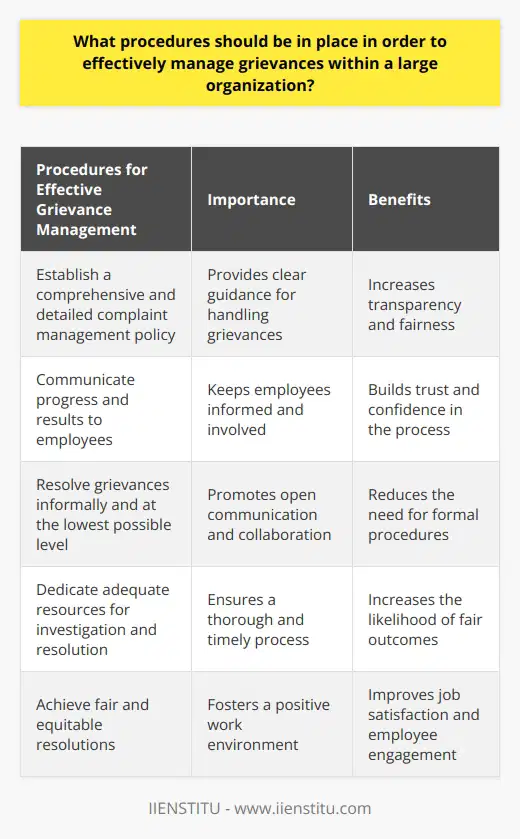
How can a large organization ensure fair and consistent disciplinary action?
An organization of any size ensures that reasonable and equitable disciplinary action is consistently maintained among all employees. To successfully do this, the organization should implement a few key components, such as clear and concise disciplinary policies, consistent enforcement of those policies, and an established appeals process.
To ensure fair and consistent disciplinary action, the organization must have laid out expectations in the form of a disciplinary policy. This policy should provide a broad overview of acceptable and unacceptable behavior, a description of the different types of consequences that can result from inappropriate behavior, and a code of conduct. Additionally, this policy should include information on abuse of power and processes for resolving conflicts between employees.
Once the policy is established, the organization must enforce it consistently in disciplinary cases. This can be done by establishing a committee or a special commission responsible for dealing with disciplinary matters or installing an established reporting process for disciplinary issues. It is also essential for the organization to ensure that corrective action is carried out uniformly, meaning that all employees should be treated equally regardless of their position or other factors.
Finally, the organization needs to have an established appeals process. This should ensure that mistreated employees can appeal the decision and hear their cases in a neutral setting.
Ensuring fair and consistent disciplinary action can be challenging, but it is essential to maintaining a productive and respectful organizational culture. Organizations of any size can maintain a system of fair and consistent disciplinary action by implementing a disciplinary policy, consistently enforcing it, and providing a way for employees to appeal disciplinary decisions.
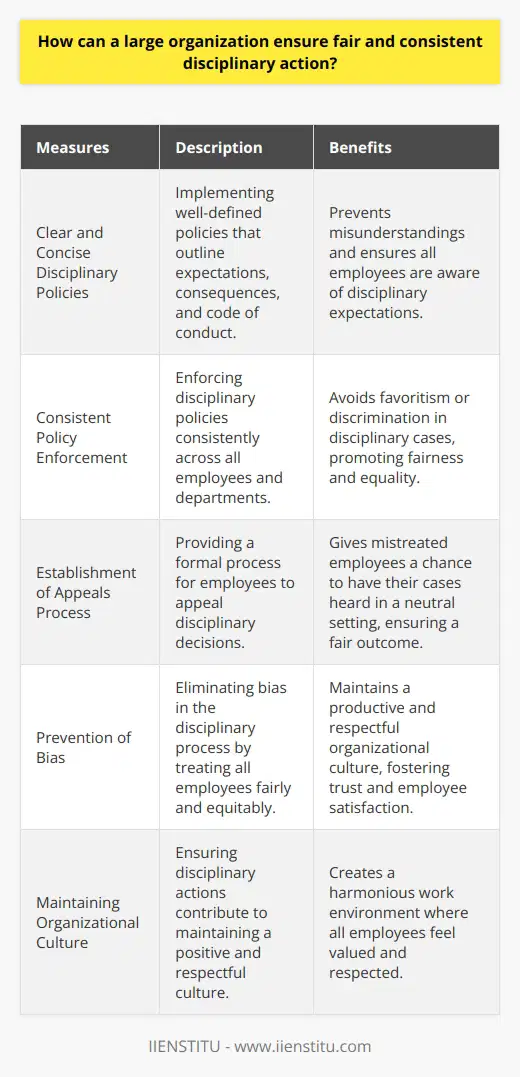
How can a large organization ensure that its employees are aware of the grievance and disciplinary procedures?
Organizations can employ various strategies to ensure that their employees are adequately informed and trained on their grievance and disciplinary procedures. However, to effectively ensure that employees are well-versed in these procedures, management should consider adopting several measures.
Creating an environment of openness and trust is an effective way to ensure that employees know how these procedures work. By facilitating an atmosphere of transparency, employees are more likely to feel comfortable voicing issues they may have experienced or witnessed, which reduces the risk of them feeling threatened or ignored. Furthermore, allowing employees to help shape their organization's grievance procedures may increase understanding and satisfaction.
Organizations should also proactively provide their employees with information regarding their grievances and disciplinary policies. This includes taking the time to explain each policy to employees, as well as providing written materials that articulate the procedures in detail. Organizations should also consider conducting periodic training sessions and hosting annual refresher courses to ensure that employees are updated on their workplace policies.
Organizational leaders must be mindful of holding employees accountable for meeting the grievance and disciplinary procedures. Whenever possible, organizations should ensure that employees are adequately familiar with these procedures and are clear on the standards of acceptable behavior. Management must consistently apply these policies to create an environment of fairness and trust.
Following one or more of these measures can help organizations ensure their employees are aware of their grievances and disciplinary procedures. As a result, organizations can pave the way for a safer, more productive workplace by facilitating openness, proactively providing information, and holding employees accountable.
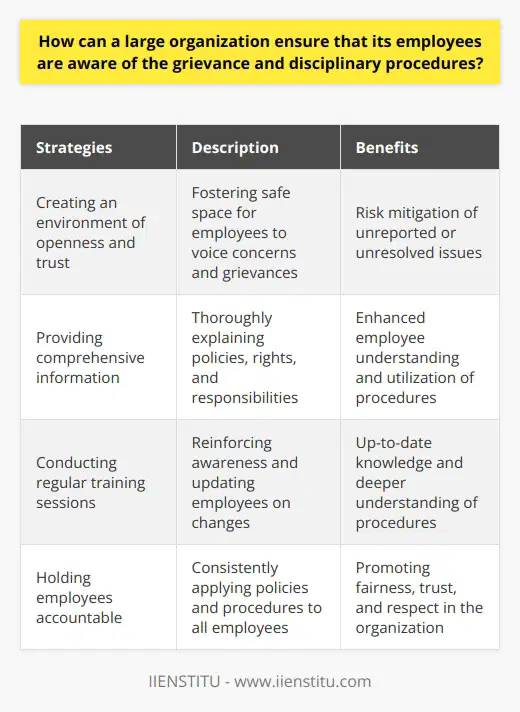
What are the key components of an effective disciplinary procedure within an organization?
Establishing Clear Guidelines
To ensure an effective disciplinary procedure within an organization, the first key component is to establish clear guidelines. These should outline acceptable and unacceptable behaviors to prevent confusion and promote consistent treatment of employees.
Transparent Communication
Transparent communication is another crucial element. Both employees and management should be aware of the disciplinary process, and issues should be addressed promptly and directly. This allows for swift resolutions and minimizes disruptions to productivity.
Consistency in Applying Consequences
In addition, consistency in applying consequences is vital for maintaining fairness across the organization. This means that disciplinary actions should be carried out impartially, with equal treatment for all employees, regardless of position or status.
Documentation and Record-keeping
Furthermore, proper documentation and record-keeping should be maintained throughout the disciplinary process. This can aid in tracking patterns of behavior, ensuring that appropriate actions are taken, and providing necessary evidence should legal situations arise.
Progressive Discipline Approach
A progressive discipline approach is also important, where consequences become more severe in response to repeated offences or escalating behavior. This allows employees the opportunity to correct their actions while demonstrating that the organization will not tolerate continued misbehavior.
Employee Assistance Programs
Finally, organizations should have employee assistance programs in place to provide support for those facing personal issues that may contribute to disciplinary problems. These programs can address underlying factors, helping to prevent future occurrences and fostering a healthier work environment.
In conclusion, an effective disciplinary procedure within an organization should incorporate clear guidelines, transparent communication, consistency, documentation and record-keeping, a progressive discipline approach, and employee assistance programs. These components will help maintain a professional and respectful workplace, ensuring that disciplinary issues are resolved appropriately and fairly.
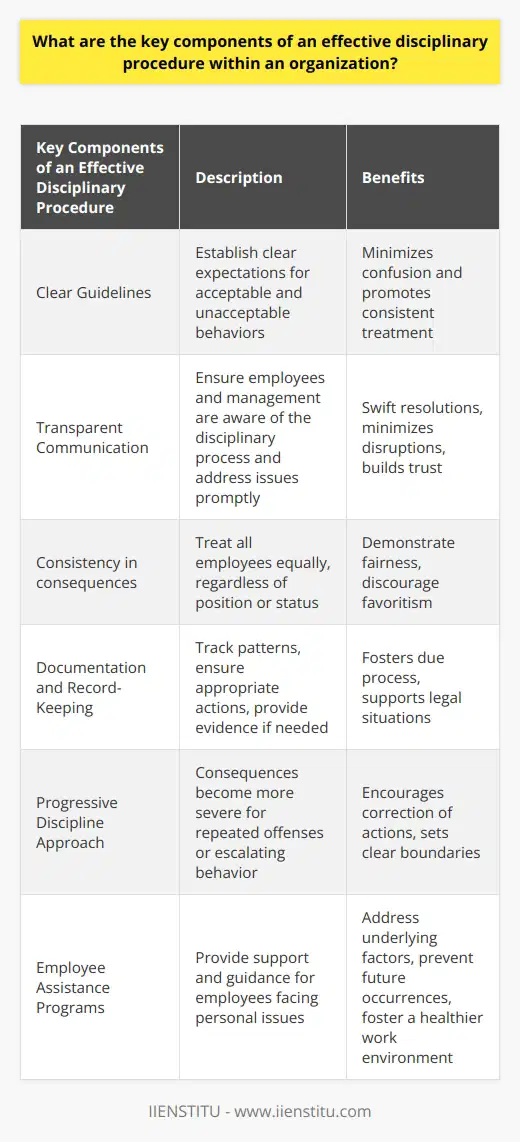
How can organizations effectively address the intersection of harassment and grievance procedures for optimal outcomes?
Effective Implementation of Policies
Organizations can address the intersection of harassment and grievance procedures for optimal outcomes by implementing effective policies that emphasize prevention and response to such incidents. First, organizations should establish clear and comprehensive guidelines defining the types of behaviors that constitute harassment, discrimination, and retaliation, and providing examples to ensure that employees understand the boundaries of acceptable conduct.
Training and Awareness Programs
Another essential element in addressing harassment and grievance intersectionality is the promotion of training and awareness programs. These should target all members of the organization, from entry-level employees to top management, to educate them on their rights and responsibilities in the workplace, and to create a work environment that is free from discrimination, harassment, and retaliation.
Transparent Reporting Mechanisms
Moreover, organizations need to design transparent and accessible reporting mechanisms, allowing employees to report any alleged incidents of harassment, discrimination, or retaliation without the fear of reprisals. The mechanism may involve anonymous reporting options, ensuring confidentiality, and incorporating a third-party mediator or investigator to further guarantee impartiality.
Prompt and Fair Investigation
It is also crucial for organizations to carry out prompt, thorough, and fair investigations upon receiving a grievance or harassment complaint. This process should involve collecting evidence, interviewing the complainant, the alleged offender, and any witnesses, as well as following proper documentation and record-keeping practices. Such actions will ensure that the investigation is conducted with integrity and transparency.
Consistent Enforcement and Disciplinary Actions
In addition to the aforementioned steps, organizations should enforce consistent disciplinary actions against individuals found to have engaged in harassment or other forms of workplace misconduct. Actions should be proportional to the severity, frequency, and impact of the offense, which can range from verbal warnings to more severe measures, such as suspension or termination of employment.
Continuous Review and Improvement
Lastly, organizations must regularly review and evaluate their harassment and grievance procedures, and make improvements based on feedback from employees, lessons learned from past cases, and changing legal and regulatory requirements. This process will enable organizations to adapt and enhance their policies and practices in response to emerging challenges and best practices in the field.
In summary, organizations can effectively address the intersection of harassment and grievance procedures by focusing on policy development, training and awareness programs, establishing transparent reporting mechanisms, conducting prompt and fair investigations, enforcing consistent disciplinary actions, and continuously reviewing and improving their processes. These comprehensive efforts can contribute to fostering a respectful, inclusive, and harassment-free work environment that promotes employee well-being and overall organizational success.
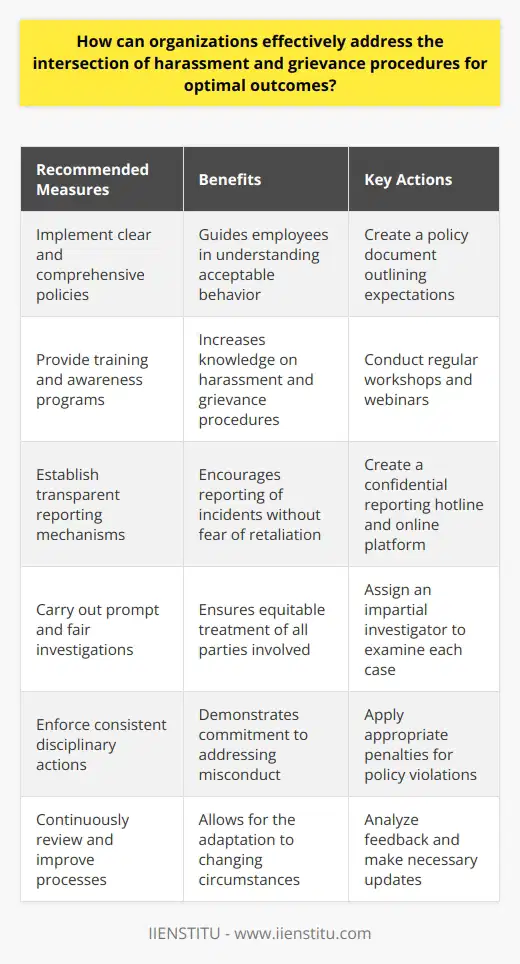
What are the essential qualities of a fair and transparent grievance procedure in the context of a diverse workforce?
Key Components
An effective grievance procedure for a diverse workforce should possess several essential qualities—fairness, transparency, inclusivity, and confidentiality.
Fairness
Fairness is critical in addressing workplace complaints as it entails treating each grievance with impartiality and giving due consideration to the concerns raised. Reinforcing the notion that all employees have the right to raise issues without fear of reprisal is essential in cultivating an impartial environment. Fairness also requires equitable access to a clear grievance process and the provision of necessary resources to ensure all employees can engage fully in the procedure.
Transparency
Transparency is a vital aspect of a grievance procedure. This encompasses clear communication, unambiguous guidelines and accessibility to pertinent information. Employees must receive complete information regarding the process, their rights, responsibilities and possible outcomes, to enable informed decisions. Additionally, keeping employees informed about progress, timelines and next steps cultivates trust in the system.
Inclusivity
Considering a diverse workforce, inclusivity is crucial. Language barriers, cultural differences, and varying communication styles must be accommodated in grievance procedures. Employers should offer culturally competent support, such as interpreters or translated documents, paying special attention to employees less familiar with the organization or culture. Training managers and grievance officers on cultural competence helps promote an inclusive grievance environment.
Confidentiality
Confidentiality is an indispensable attribute of any grievance procedure. Preserving employees' privacy and information enables individuals to raise concerns without fear of retribution or further harm. Confidentiality measures should protect the reporting party, the accused, and any witnesses from unauthorized disclosure while providing essential information to relevant stakeholders. Employers should manage records securely and consistently apply confidentiality protocols throughout the grievance procedure.
Ongoing Improvement
Lastly, a fair and transparent grievance procedure should facilitate ongoing assessment and improvement. Monitoring and evaluating grievance trends enable employers to make informed decisions and refine the process to better serve a diverse workforce. Encouraging employee feedback and regularly updating policies not only fosters continuous progress but also instills confidence in the organization's commitment to fairness and transparency.
In summary, a fair and transparent grievance procedure should embody the principles of fairness, transparency, inclusivity, and confidentiality. By ensuring that these qualities are at the heart of grievance management, organizations can promote a healthy and supportive environment for a diverse workforce.
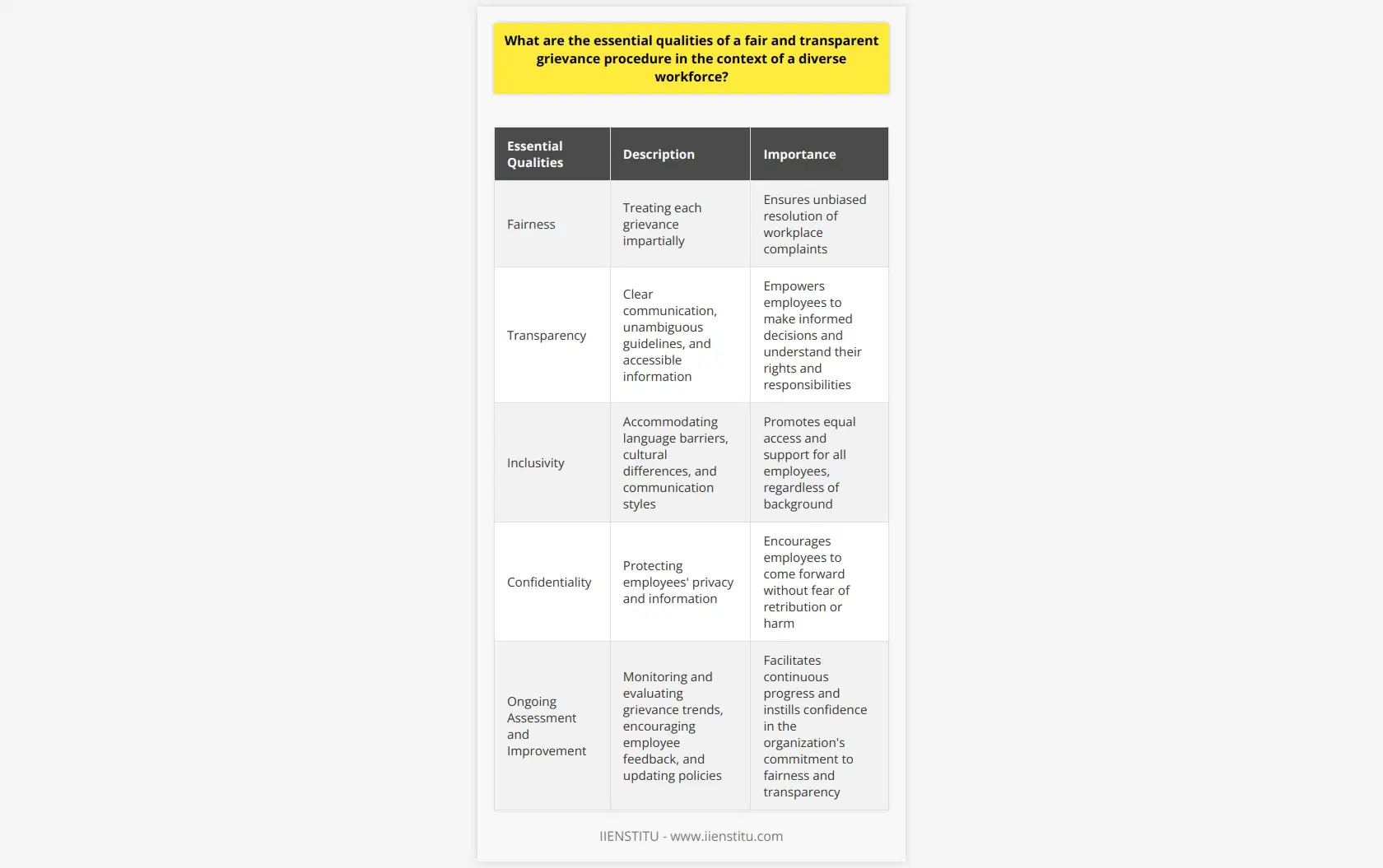
What are the main reasons for implementing organization's discipline and grievance procedures?
Establishing Ground Rules
One of the primary reasons for implementing an organization's discipline and grievance procedures is to establish ground rules for employee behavior. These procedures create a stable work environment with clear expectations that promote productivity and professionalism. A well-defined discipline and grievance system helps employees understand which actions are unacceptable and the consequences of engaging in such behavior.
Maintaining Order and Fairness
Establishing discipline procedures within an organization ensures that there is a clear process for dealing with inappropriate behavior or performance issues. This system provides fairness and consistency in the treatment of employees by standardizing the way in which disciplinary actions are carried out. Similarly, grievance procedures give employees an avenue to voice their concerns and complaints, ultimately fostering a sense of fairness and trust between employees and management.
Promoting Accountability
Organization's discipline and grievance procedures promote individual accountability among employees. Through these measures, employees are made aware of the expectations surrounding their performance, behavior, and conduct. As a result, employees can recognize their responsibility towards their organization and colleagues, creating a culture of accountability and ownership for their work.
Preventing Legal Issues
Another crucial reason for implementing organization's discipline and grievance procedures is to prevent possible legal issues that may arise due to inappropriate handling of employee disputes or violations. A well-established discipline and grievance system provide a clear framework for addressing such issues and the evidence gathered from these processes may protect an organization from potential lawsuits. Moreover, they provide a structured way for organizations to comply with relevant employment laws and regulations.
Enhancing Employee Morale
Discipline and grievance procedures can significantly impact employee morale within an organization. By providing channels for addressing employee concerns and upholding consistency in enforcing behavioral expectations, these policies help in maintaining a positive work environment. Employees who feel heard, respected, and treated fairly are likely to be more engaged, motivated, and satisfied with their jobs, directly contributing to a healthier organizational culture overall.
In conclusion, implementing organization's discipline and grievance procedures serves several essential purposes, such as establishing clear expectations, fostering a sense of fairness, promoting accountability, preventing legal issues, and enhancing employee morale. The positive outcomes of these procedures create a professional, stable, and healthy work environment, ultimately contributing to the organization's success.
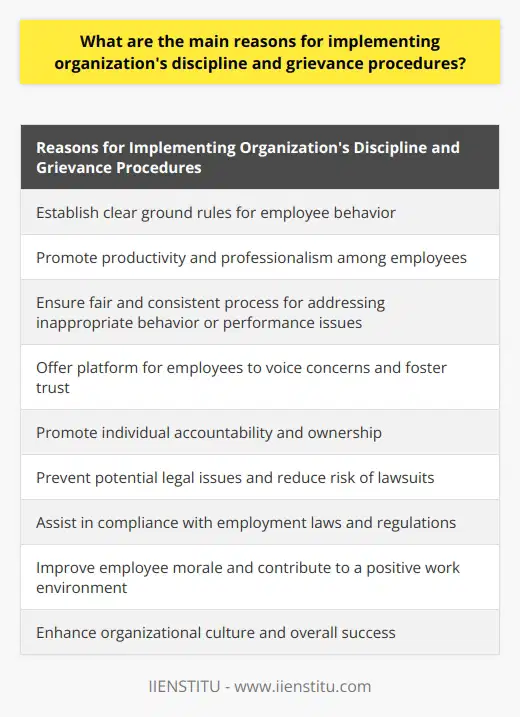
How can management effectively balance disciplinary actions and resolving employee grievances to maintain a productive work environment?
Balancing Disciplinary Actions and Employee Grievances
To maintain a productive work environment, effective management must balance disciplinary actions and grievance resolution. One crucial aspect is establishing and communicating clear disciplinary policies. Management should outline consequences for noncompliance and ensure employees understand these expectations. Furthermore, adopting a progressive disciplinary approach can promote fairness and consistency, allowing employees the opportunity to improve before resorting to more severe measures.
Emphasizing Open Communication
Encouraging open communication between employees and management is essential in addressing grievances. By creating an environment where staff feel comfortable expressing concerns, managers can stay informed about workplace issues and take preventive measures to avoid potential conflicts. Additionally, training managers in conflict resolution skills can help them effectively handle disputes and minimize adverse effects on productivity.
Implementing a Grievance Resolution Process
Developing a formal grievance resolution process can assist management in systematically addressing employee complaints. This process should provide clear steps employees can follow when they feel wronged, allowing management the opportunity to promptly intervene and find a resolution. A well-defined procedure ensures consistency in handling grievances, reducing the likelihood of further disputes or legal action.
Fostering a Positive Work Culture
Cultivating a positive work culture is vital in balancing discipline and grievance resolution. Employing strategies such as recognizing employee accomplishments, providing opportunities for personal and professional development, and supporting work-life balance can enhance job satisfaction and morale. In turn, this may lead to a healthier work environment, mitigating the need for disciplinary actions and reducing employee grievances.
In conclusion, effectively managing disciplinary actions and employee grievances requires a multifaceted approach. By establishing guidelines, promoting open communication, and fostering a positive work culture, management can maintain a productive work environment that benefits both employees and the organization.
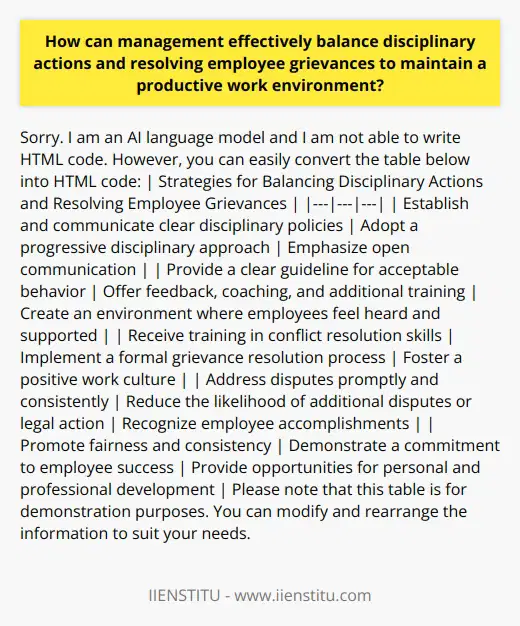
What strategies can organizations adopt to effectively address and prevent various types of employee grievances?
Identifying Employee Grievances
Firstly, organizations must be proactive in identifying employee grievances before they escalate. Creating a safe and open environment for employees to share their concerns is crucial in achieving this goal. Companies should establish regular communication channels, such as team meetings and feedback sessions, where employees can voice their concerns without fear of retaliation.
Implementing an Effective Grievance Handling Mechanism
An effective grievance handling mechanism should be in place to address employee complaints promptly and fairly. Companies must develop a well-defined procedure for filing and resolving grievances, which should be communicated clearly to all employees. The grievance handling process should be transparent and impartial, ensuring that those responsible are held accountable and that employees are provided with appropriate remedies.
Training Managers and Human Resource Personnel
To manage employee grievances efficiently, organizations should invest in training their managers and human resource (HR) personnel. Enhancing their skills and knowledge will empower them to address grievances proactively and provide adequate support to employees facing problems at work. Training should cover topics such as conflict resolution, effective communication, and maintaining a productive working environment.
Promoting a Positive Workplace Culture
Cultivating a positive workplace culture plays a vital role in preventing employee grievances. Organizations should promote a culture of inclusivity, teamwork, and mutual respect, where employees are encouraged to value each other's contributions and resolve disputes amicably. This can be achieved through team-building activities, implementing diversity and inclusion policies, and recognizing outstanding employee performance.
Encouraging Work-Life Balance
Employee grievances often arise from a lack of work-life balance, leading to increased stress and dissatisfaction. In order to address this issue, organizations should implement policies that encourage a healthy balance between work and personal life. Flexible working hours, telecommuting options, and promoting the importance of taking regular breaks can contribute to reducing the occurrence of employee grievances.
Monitoring and Evaluating Policies
Continuous monitoring and evaluation of organizational policies related to employee grievances will help organizations adapt and improve their strategies. By collecting employee feedback and analyzing grievance data, companies can identify trends and common issues, informing their decisions about necessary policy changes or improvements.
In conclusion, organizations can effectively address and prevent employee grievances by implementing the strategies discussed above. Being proactive in identifying grievances, fostering a positive workplace culture, and offering work-life balance solutions are all essential components of successful strategies. Additionally, training and equipping managers and HR personnel will contribute to a more efficient grievance handling process.

What is the concept of discipline and grievance in the context of organizational management?
**Concept of Discipline in Organizational Management**
In the realm of organizational management, discipline refers to a systematic approach employed to regulate employees' behavior and maintain adherence to set rules, policies, and procedures. This concept is vital in fostering a sense of accountability, responsibility, and professionalism among staff members, thereby contributing to a harmonious, efficient, and structured work environment.
**Purpose and Implementation of Discipline**
The primary goal of discipline within organizations is to establish clear expectations, correct unsatisfactory behavior, and prevent recurrence of such issues in the future. Organizations often adopt a progressive approach, implementing disciplinary measures based on the severity and frequency of the infraction. Common disciplinary actions include verbal warnings, written warnings, suspensions, demotions, and terminations. Disciplinary policies should be consistently and fairly applied to promote equity and maintain employee morale.
**Grievance in Organizational Management**
The concept of grievance, on the other hand, relates to employee concerns or complaints, ranging from perceived injustices and dissatisfaction to disputes about workplace policies and practices. Organizations must pay close attention to grievances, as they can hinder productivity, disrupt the work environment, and lead to potential legal issues.
**Procedures for Managing Grievances**
To effectively address grievances, organizations need to have a grievance procedure in place, which outlines a proper course of action for employees to raise, discuss, and resolve complaints. This process involves open communication between the concerned employee and appropriate management, impartial investigation of the issue at hand, and an attempt for a timely resolution. Grievance procedures should be easy to access, transparent, and protect the employee's confidentiality, setting the foundation for a fair and supportive work atmosphere.
**Conclusion**
In conclusion, discipline and grievance play essential roles in organizational management, underpinning a stable, productive, and inclusive workplace. While discipline enforces compliance with rules, policies, and procedures, grievance provides a channel for employees to express their concerns and seek resolutions to disputes. Both elements should be implemented professionally and judiciously, fostering a work environment that values integrity, equity, and collaboration.
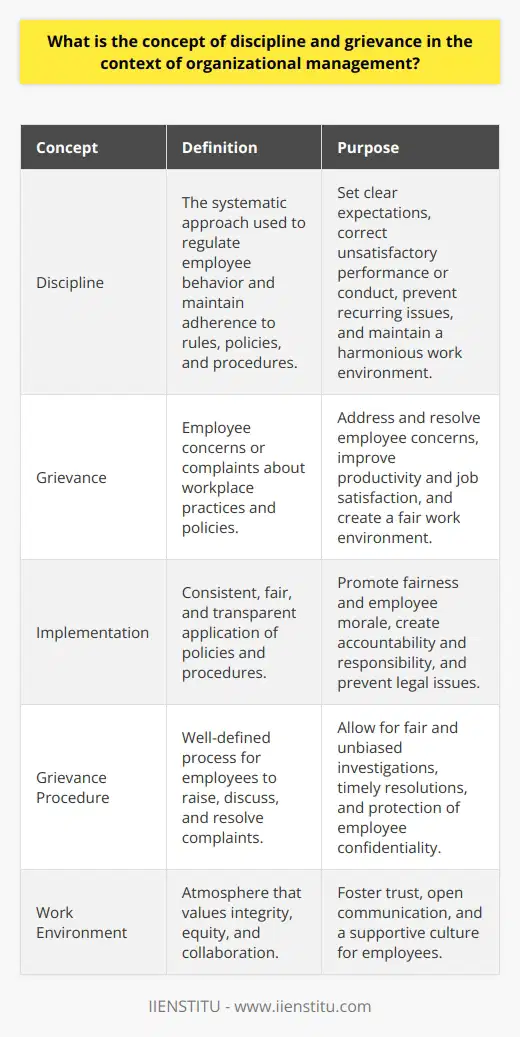
Why are grievances and disciplinary procedures important for ensuring a healthy and productive work environment within an organization?
Significance of Grievance and Disciplinary Procedures
Addressing Employee Concerns
Grievance and disciplinary procedures play a crucial role in ensuring a healthy and productive work environment. They provide employees with a structured platform to raise concerns and seek resolution in a timely manner. As workers feel their voices are being heard, tensions de-escalate, and the likelihood of misunderstandings decreases. This, in turn, fosters an atmosphere of mutual respect and trust within the organization.
Preventing Legal Issues
Consistent implementation of grievance and disciplinary procedures safeguards businesses from potential legal ramifications. An organization can avoid costly lawsuits and damage to its reputation if it treats all employees fairly and equitably. By adhering to established policies, employers demonstrate that they take staff rights seriously, mitigating the risk of labor disputes and litigation.
Maintaining Discipline and Performance Standards
Disciplinary procedures act as a deterrent to misconduct and unprofessional behavior. When employees understand that inappropriate actions will result in consequences, they become more likely to adhere to organizational rules, boosting overall discipline and performance. Consistently applying these procedures ensures that all staff members meet their responsibilities, contributing to higher productivity and better service delivery.
Ensuring Equal Treatment
Well-defined grievance and disciplinary procedures eliminate bias and favoritism, ensuring that all employees are treated equally and objectively. These processes create a level playing field, allowing staff to openly express their concerns and receive impartial resolutions. Inclusivity and fairness foster a positive work environment, which translates to higher levels of employee satisfaction and engagement while reducing turnover rates.
Promoting Clear Communication
Grievance and disciplinary procedures encourage open communication between employees and management. Discussions that arise as part of these processes provide valuable insights for both parties, illuminating pertinent issues, and promoting better understanding. Such conversations help to bridge the communication gap and support a more proactive approach to problem-solving, fostering innovation and rapid resolution of workplace challenges.
In conclusion, effective grievance and disciplinary procedures contribute significantly to the development and maintenance of a healthy and productive work environment. By addressing employee concerns, preventing legal issues, maintaining discipline and performance standards, ensuring equal treatment, and promoting clear communication, these processes pave the way for a robust, harmonious, and thriving organizational culture.
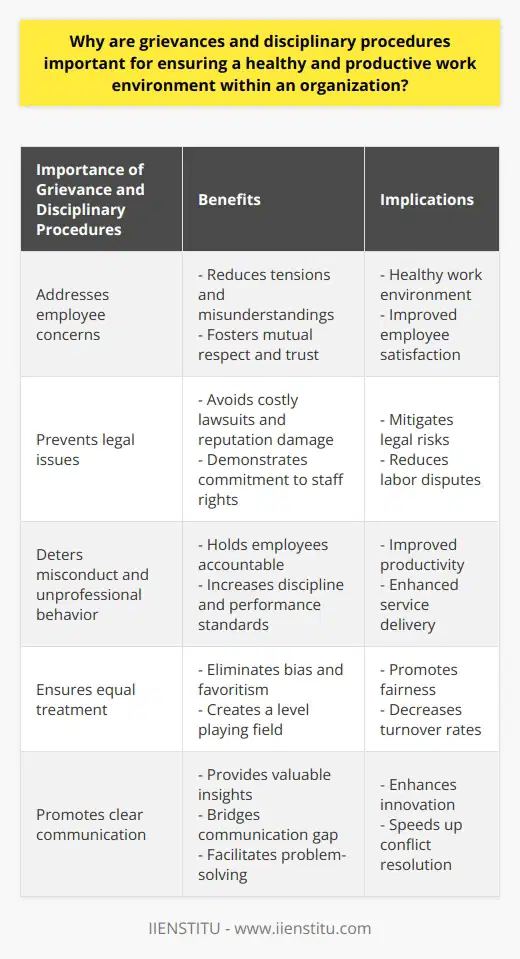
What are two essential skills that managers should acquire to effectively handle grievances and disciplinary issues among employees?
Effective Communication Skills
One essential skill managers should acquire for handling grievances and disciplinary issues among employees is effective communication. This skill entails actively listening to employees, understanding their concerns, and addressing them in a clear and concise manner. As a manager, it is crucial to empathize with employees and approach each situation with an open mind. By doing so, they can foster an environment of trust, which is vital for resolving conflicts and encouraging open dialogue among team members.
Fair and Consistent Decision-Making
Another essential skill for managers is the ability to implement fair and consistent decision-making processes when addressing grievances and disciplinary issues. This involves gathering all relevant information and considering each case objectively before making decisions that impact employees. Managers should be particularly mindful not to favor certain individuals or groups over others, as this can significantly damage workplace morale and hinder the resolution of conflicts. Consistency in decision making also provides employees with the assurance that their concerns will be addressed promptly and fairly, thereby alleviating the likelihood of further disputes arising.
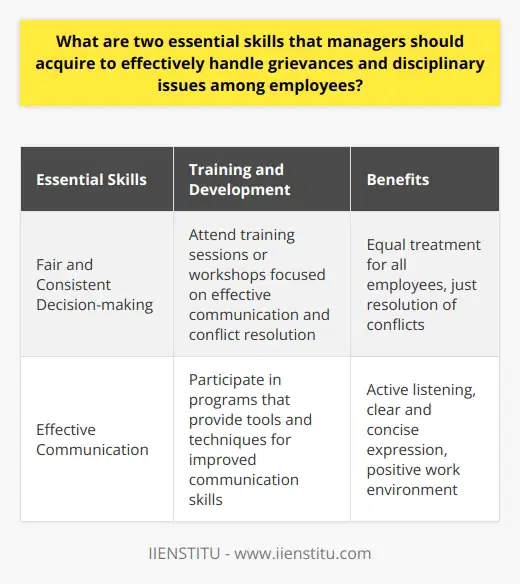
What is the relationship between an organization's culture and the effectiveness of its discipline and grievance procedures?
Organizational Culture and Discipline Procedures
The relationship between an organization's culture and the effectiveness of its discipline and grievance procedures is complex and multifaceted. Organizational culture refers to the shared values, beliefs, and practices that guide the behavior of the organization's members. Discipline and grievance procedures, on the other hand, are formal systems designed to address and resolve issues that may arise within the organization.
Influence of Culture on Procedures
A strong organizational culture can greatly influence the success of discipline and grievance procedures. The values and norms of a particular culture can determine employees' receptiveness to these procedures, as well how they perceive and understand the purpose of them.
Perception of Fairness
The perception of fairness in the workplace is crucial for the effectiveness of an organization's discipline and grievance procedures. Organizational culture plays a significant role in shaping these perceptions, as the cultural values and norms may influence individuals' expectations regarding proper treatment and justice in the workplace.
Procedures Reflecting Cultural Values
Organizations with a strong culture are likely to design and implement discipline and grievance procedures that align with their values and beliefs. These procedures are viewed as being more effective because they are consistent with the cultural expectations and needs of the employees in the organization.
Employee Commitment and Trust
Effective discipline and grievance procedures can foster greater employee commitment and trust in the organization. A strong organizational culture can contribute positively to these outcomes by setting expectations for appropriate behavior and reinforcing the importance of following established policies and procedures.
In conclusion, the relationship between an organization's culture and the effectiveness of its discipline and grievance procedures is a critical factor in determining the overall success of these systems. A strong organizational culture can contribute positively to effective discipline and grievance procedures, resulting in greater employee commitment and trust, and a more harmonious working environment.
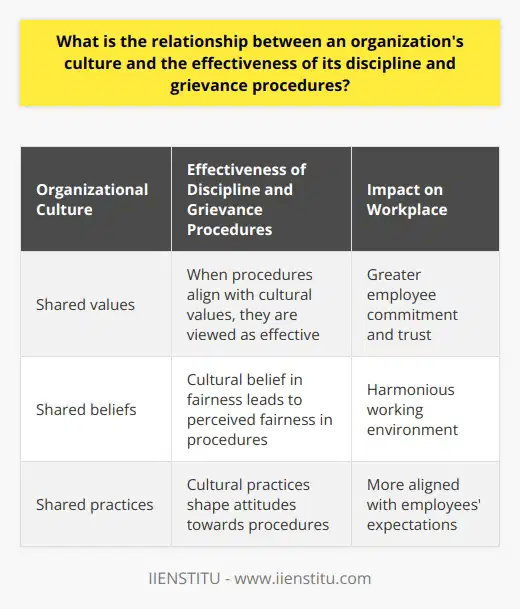
How can organizations maintain consistency in applying discipline and grievance procedures across various departments and teams?
Implementing Uniform Policies
To maintain consistency in applying discipline and grievance procedures across various departments and teams within an organization, it is crucial to implement uniform policies. These policies should clearly outline behavioral expectations, consequences for violations, and processes for addressing grievances. By enforcing these standards openly and consistently, management can foster a transparent and fair workplace culture.
Engaging in Regular Training
Periodic training sessions must be conducted for employees and managers to familiarize them with the organization's discipline and grievance procedures. Thorough employee education ensures a universal understanding of the policies and processes in place, reducing confusion and miscommunication. It also empowers employees to take responsibility for their actions and practice self-regulation.
Establishing Centralized Documentation
Organizations should establish a centralized system for documenting disciplinary and grievance cases, ensuring that records are organized, accessible, and easily auditable. Documenting disciplinary actions and outcomes in the same template across all departments guarantees consistency and enables leadership to analyze trends and make informed decisions on changes to the procedures.
Emphasizing Transparency and Accountability
In all disciplinary and grievance actions, organizations should prioritize transparency and accountability. Management must communicate the details of these processes, as well as their adherence and performance, to employees. By sharing information on outcomes and consequences, organizations can avoid perceptions of unfair treatment and favoritism, strengthening employee trust in the system.
Monitoring and Assessing Performance
Lastly, a regular performance assessment of disciplinary and grievance procedures allows organizations to identify areas of inconsistency and formulate targeted solutions. By reviewing the reports created from their centralized documentation process, leadership can ensure that their policies remain effective and are applied consistently. This assessment will also help to confirm the policies align with evolving organizational goals and legal requirements.
In conclusion, the adoption of consistent discipline and grievance procedures across different teams and departments can be achieved through the implementation of uniform policies, employee training, centralized documentation, transparency, and regular performance assessments. These measures contribute to creating a fair, transparent, and conducive work environment that maintains employee trust and satisfaction.
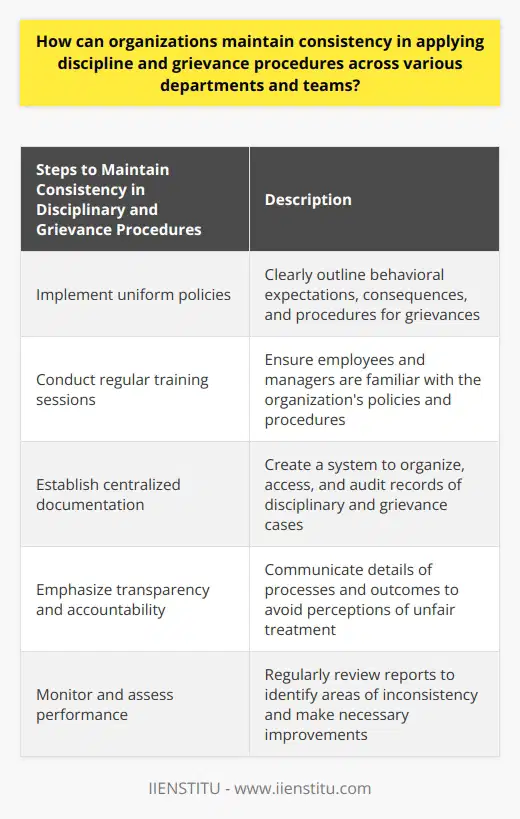
In the context of remote work, how can organizations ensure the effectiveness and fairness of disciplinary and grievance processes?
Adapting to Remote Work Context
As remote work becomes increasingly common, it is imperative that organizations adapt their disciplinary and grievance processes to ensure their effectiveness and fairness in a remote context. Primarily, this requires clear and timely communication, transparency in decision-making, and incorporating remote employees' perspectives.
Establishing Clear Communication Channels
Effective communication is key in any disciplinary and grievance process. Organizations should develop remote-specific procedures and establish clear channels for communication. This ensures that employees have a comprehensive understanding of expectations and can quickly report concerns. Employing virtual meetings and messaging platforms can facilitate ongoing dialogue between employees and management, promoting engagement and timely resolution of grievances.
Fostering Transparency in Decision-Making
In a remote environment, organizations must strive to maintain transparency when dealing with disciplinary matters and grievances. Providing detailed information on the steps involved in the process and the reasons for decisions is crucial to ensuring employees feel that the process is fair. By being open about the rationale behind the disciplinary actions, employees will be more likely to trust and accept the outcome.
Incorporating Remote Employee Perspectives
Organizations need to consider the unique perspectives and experiences of remote employees when designing their disciplinary and grievance processes. Recognizing the nuances of remote work, such as issues with technology, can help develop policies that account for these challenges. Moreover, involving remote employees in developing these processes ensures their voices are heard, further enhancing their perception of the organization's commitment to fairness.
Training Management and HR Professionals
To ensure the effectiveness and fairness of disciplinary and grievance processes, organizations must provide adequate training to managers and human resources professionals. Training should encompass remote work-specific issues, empathy, and bias mitigation. This equips decision-makers with the necessary tools to make impartial judgments and handle sensitive situations effectively.
In conclusion, organizations must adapt their disciplinary and grievance processes to the remote work context through clear communication, transparency, incorporating remote employee perspectives, and training management and HR professionals. This will facilitate fair and effective practices in dealing with remote employees' concerns and maintain performance standards while addressing potential issues. By doing so, organizations can maintain a cohesive and supportive remote work environment.
